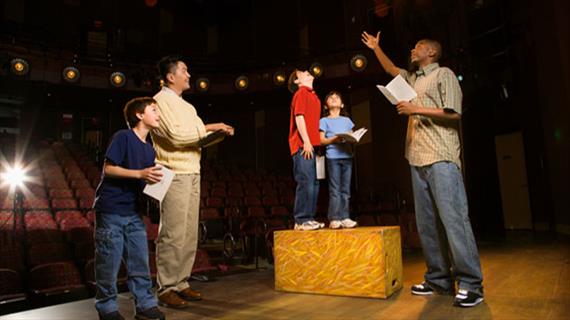Contributed by Dana Truby
Readers Theater is a great way to enrich your students’ reading practice and bring joy to reading class at the same time. Performing plays engages students and helps get them excited about reading and theater. It also builds valuable skills, increasing comprehension and fluency. Here’s how to get started.
1. Research Readers Theater Plays
With a little adaptation, Readers Theater can be performed with many kinds of literature: picture books, short stories, parts of novels, poetry, folktales, works of nonfiction, and newspaper or magazine articles. You can also find collections of Readers Theater scripts online. There are also books of Readers Theater plays arranged by grade level or theme (Greek myths, American history, etc.) from educational publishers such as Scholastic and Evan-Moor.
2. Model Expressive Reading
Once you’ve chosen a play, start by reading it several times while students follow along. Ideally, you should make copies for each student and project the play with an interactive whiteboard, document camera or projector. Use your readings to model how expression, pace and inflection help communicate meaning. For example, take a sentence from the play and read it slowly and then quickly. Read it quietly and then loudly and grumpily. Ask kids: How does the way we read a line affect it’s meaning? Then, invite kids to read aloud with you.
3. Try Choral and Echo Reading
Choral and echo reading are great techniques for giving your students the confidence and practice they need before they read aloud on their own. It also helps to build fluency. To do choral reading, you and your students read together as a group. That way all your students read at the same pace and with the same phrasing and intonation as the rest of the group. In echo reading, you read a line and students then repeat it, echoing your expression, tone and pacing.
4. Assign Readers Theater Roles
After you read the play aloud together, have students take turns reading the play aloud. If some of your students are reluctant to read aloud, assign two readers to each role. If you are using a document camera or projector, assign one student the role of “pointer.” He or she can point to each line of dialogue in turn. If students have copies of the play, have them use highlighters to mark their passages. Give them time to read over their lines before reading it aloud.
5. Teach the Laws of the Theater
Explain to your students that they need to speak loudly so that their voices can be heard easily. Encourage students not to worry about small mistakes. Tell themto just ignore a slip-up and keep going. If the audience laughs, pause until they stop and keep going. The show must go on!
6. Form Readers Theater Groups
After you’ve done a few plays as a whole class, consider breaking your class into groups and having them perform a new Readers Theater play, one related to your curriculum. Encourage group members to work together and decide how they want to perform the play. Together, they can experiment and explore the characters. What voices will they use? Will they make simple props? The different performances of the same play will give students extra opportunities to observe Readers Theater technique and to absorb the story.
7. Share the Wealth
Consider having your students perform their Readers Theater plays for another class in the same grade or the grade below. Students could perform for parents at an event—or videotape the readings and share them online for families to enjoy.
8. Write Your Own Plays
Once your students become truly comfortable with Readers Theater, challenge them to do their own story to play adaptations. Have students work in pairs. Each pair can choose a story, tale or biography related to your curriculum and adapt it to perform for the class. What a great way to build shared knowledge!
How do you use Readers Theater in your classroom?

